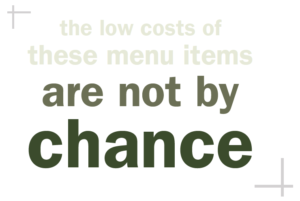Price: The 4 Ps of marketing — selling junk food to communities of color
Thursday, July 25, 2019Last year, Burger King announced that it would be selling 100 chicken nuggets for $10.1 Taco Bell's Cravings Value Menu includes options such as the Beefy Fritos Burrito or the Cinnabon Delights 2-pack for $1.2 And when McDonald's relaunched its Dollar Menu at the beginning of 2018, the company included cheeseburgers for $1 and Happy Meals for $3.3 The price of a product may not seem like marketing, but the low costs of these menu items are not by chance — they represent a strategic marketing tactic to attract people from low-income communities.

Fast-food restaurants and the wider food and beverage industry carefully set prices to appeal to certain groups. However, many of the foods and beverages marketed to low-income communities and communities of color — and sold at low prices — such as sodas, processed snacks, and fast-food meals, are also low in nutrients and high in sugars, salt, and fats.4 These junk foods can increase risk of diet-related diseases or interfere with management of chronic conditions — especially in the absence of healthier food and beverage options. Meanwhile, communities of color have been the hardest hit by the current epidemic of diabetes and other nutrition-related diseases.5
Adjusting prices is just one of the many ways that companies engage in target marketing, the practice of using tailored approaches to sell products to specific groups, such as communities of color.
What is target marketing?
Target marketing applies the "marketing mix" principles: product, price, place, and promotion. The "4 Ps" model is foundational to today's digital marketplace and is widely adopted by both marketing practitioners and academics. Some business experts also add other Ps, such as "personalization," to the mix.

The targeted marketing of unhealthy food and beverages to communities of color is common across all four marketing mix categories, as companies have designed:
- products especially for communities of color;
- prices designed to appeal to specific income groups, such as "value menus" targeting low-income neighborhoods, as communities of color are disproportionately represented within them;
- places that are saturated with unhealthy food products, due to zoning in certain communities that allows concentrations of fast-food restaurants or proliferation of outdoor advertising of unhealthy food and sugary beverages6; and
- promotions that exploit cultural images, symbolism, and language that are recognizable to communities of color to sell products or build brand loyalty.
In this brief, we explain how the marketing mix principle of "price" works and why targeting foods and drinks high in sugars, salt, and fats to communities of color contributes to health inequities.
Unhealthy foods and drinks are the best bargains
In low-income neighborhoods, where communities of color are disproportionately represented, healthier foods and beverages are often priced out of reach or lose out to less expensive but less healthy options at the local grocery store — that is, if there is one. In urban and rural areas alike, there are food deserts that lack affordable grocery stores or produce markets, as well as "food swamps." Food swamps offer an abundance of fast-food restaurants, convenience stores, and corner liquor stores where soda is cheaper than bottled water or other healthier beverages, and fresh fruit and vegetable selections are limited.7
Fast-food restaurants, with their low-cost pricing strategies that include "value menus," also play a significant role in the spread of diabetes and other nutrition-related diseases among communities of color. There is often a preponderance of fast-food establishments in these communities that capitalize on sizeable target markets and less restrictive zoning rules. And it's no secret that fast food is largely unhealthy food, with many products high in saturated fat, sodium, and sugar.8
A high price to pay for low-cost food
Price was among the strongest — if not the strongest — influence on food purchases, particularly among low-income consumers, according to a 2013 American Journal of Public Health study, "What 'Price' Means When Buying Food: Insights from a Multisite Qualitative Study with Black Americans."9
The study showed how food price can affect caloric consumption by the types or quantities of foods purchased. "For example, people may buy relatively inexpensive snack foods and convenience foods that are high in fat and sugar. They also may feel less guilty about buying unhealthy foods if they are discounted and may eat relatively more of the products acquired at low cost or stockpiled because of quantity discounts."9
More recently, a January 2018 report in Preventive Medicine concluded that "foods that are energy dense [high in calories] and generally considered unhealthy tend to be the most affordable. The price of food is associated with food purchasing decisions and consumption, and thus price differences between healthy and unhealthy foods are expected to be associated with the effects of diet, including diabetes and insulin resistance."10

This imbalance in the cost of healthy versus unhealthy food is perhaps most evident in Indian Country. A 2016 report from the First Nations Development Institute showed that most healthy food staples, such as eggs, milk, apples, and tomatoes, cost considerably more than the nationwide average. One item they found less expensive: Cheetos.11
"The lower price of Cheetos in Indian communities is disturbing," noted a 2016 news report about the study in Indian Country Today.12 "The report said that it may be the result of normal price-setting procedures but speculated that a 'cynical view of this pricing is that some junk foods are always more inexpensive in Native communities, where demand is high from Native consumers.'"
What can we do?
Food and beverage companies must stop aggressively marketing their least healthy products to communities of color. We cannot accept price discrepancies between healthy and junk food as simply a function of market supply and demand. Acknowledging our shared responsibility to keep all communities safe and happy, we encourage continued direct dialogue among industry leaders, community residents, and health advocates to advance solutions that will help companies improve the nutritional quality of products being marketed and sold to communities of color and low-income communities.
Price and the other principles of marketing are not used in isolation, so we encourage advocates to address the different tactics at the same time. For example, advocates could encourage restaurants to participate in the Children's Food and Beverage Advertising Initiative, which ensures minimum nutrition standards for foods marketed to kids. Additionally, community leaders could ask whether companies are spending as much to market nutritious products as they are to promote salty, sugary, high-fat products; they could also organize digital app opt-out campaigns in communities of color to counter low-cost junk food promotions and send a message to the industry. When properly publicized, this tactic would be an effective way to reach the industry because apps and digital platforms are important for the companies' future revenue and brand goals.
To learn more about this issue and ways to combat it, read the rest of our target marketing series, join the target marketing subcommittee of the Food Marketing Workgroup, a coalition of organizations and individuals dedicated to eliminating unhealthy food marketing to young people, especially youth of color. Those interested in joining can email workgroup co-chair and subcommittee lead Berkeley Media Studies Group at info@bmsg.org.
References
1. Chayes Wida E. Cheapest chicken ever? Burger King is selling 100 chicken nuggets for $10. TODAY. https://www.today.com/food/burger-king-selling-10-chicken-nuggets-1-t139337. Published October 10, 2018. Accessed April 15, 2019.
2. Luna N. Taco Bell rebrands dollar menu as Cravings Value Menu. Nation's Restaurant News. https://www.nrn.com/marketing/taco-bell-rebrands-dollar-menu-cravings-value-menu. Published December 13, 2018. Accessed April 15, 2019.
3. Gajanan M. The McDonald's Dollar Menu is back. Here's what you can get. Money. http://money.com/money/5085896/mcdonalds-dollar-menu/. Published January 4, 2018. Accessed April 15, 2019.
4. Harris JL, Frazier III W, Kumanyika S, Ramirez A. Increasing disparities in unhealthy food advertising targeted to Hispanic and Black youth. UConn Rudd Center for Food Policy and Obesity. http://uconnruddcenter.org/files/Pdfs/TargetedMarketingReport2019.pdf. Published January 2019. Accessed April 11, 2019.
5. Committee on Accelerating Progress in Obesity Prevention; Food and Nutrition Board; Institute of Medicine. Accelerating progress in obesity prevention: Solving the weight of the nation; 2012. doi:10.17226/13275
6. Ohri-Vachaspati P, Isgor Z, Rimkus L, Powell L, Barker D, Chaloupka F. Child-directed marketing inside and on the exterior of fast food restaurants. Am J Prev Med. 2014;48(1):22-30.
7. Cooksey-Stowers K, Schwartz MB, Brownell KD. Food swamps predict obesity rates better than food deserts in the United States. Int J Environ Res Public Health. 2017;14(11). doi:10.3390/ijerph14111366
8. Cheyne A, Mejia P, Nixon L, Dorfman L. Food and beverage marketing to youth. Current Obesity Reports. 2014; 3(4): 440-450.
9. DiSantis KI, Grier SA, Odoms-Young A, et al. What "price" means when buying food: Insights from a multisite qualitative study with Black Americans. Am J Public Health. 2013;103(3):516-522. doi:10.2105/AJPH.2012.301149
10. Kern DM, Auchincloss AH, Stehr MF, et al. Neighborhood price of healthier food relative to unhealthy food and its association with type 2 diabetes and insulin resistance: The multi-ethnic study of atherosclerosis. Prev Med. 2018;106:122-129. doi:10.1016/j.ypmed.2017.10.029
11. First Nations Development Institute. Indian Country food price index: Exploring variation in food pricing across Native Communities. https://www.firstnations.org/publications/indian-country-food-price-index-exploring-variation-in-food-pricing-across-native-communities/. Published 2016. Accessed April 15, 2019.
12. Lee TH. 7 foods that cost more on the rez, and one junk food that costs less. Indian Country Today. https://newsmaven.io/indiancountrytoday/archive/7-foods-that-cost-more-on-the-rez-and-one-junk-food-that-costs-less-jtn1vafQKEuoLZTvYY3xJw/. Published July 12, 2016. Accessed April 15, 2019.
Acknowledgments
This brief was written by Fernando Quintero, with editing support from Lori Dorfman, Heather Gehlert, and Daphne Marvel. Thanks to Sarah Han and Heather Gehlert for design contributions.
This brief was funded by a grant from the Robert Wood Johnson Foundation.
© 2019 Berkeley Media Studies Group, a program of the Public Health Institute




